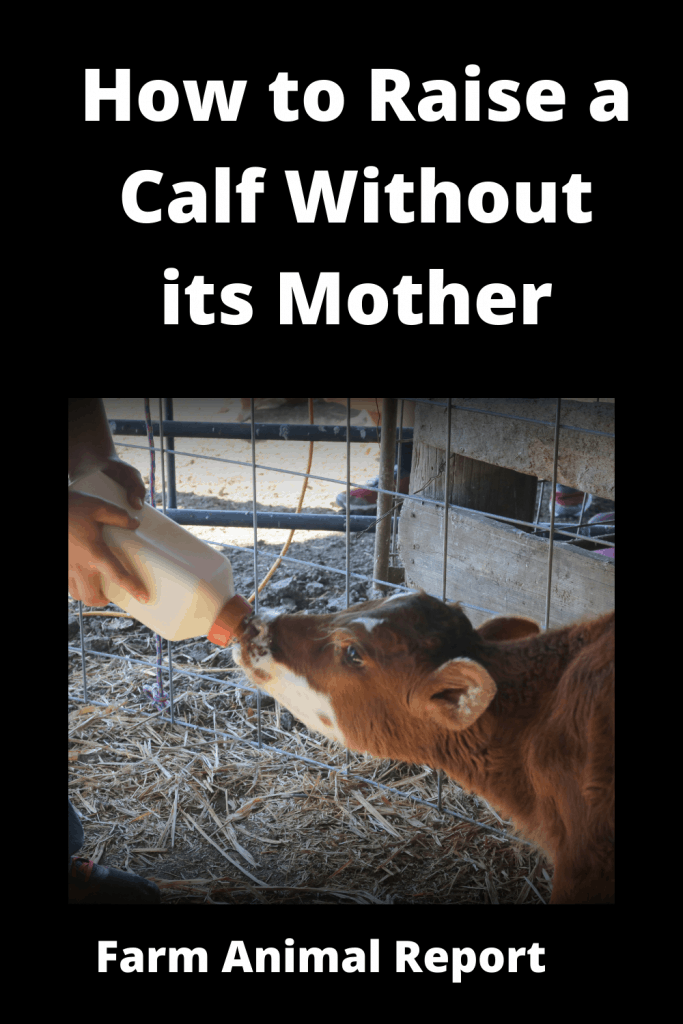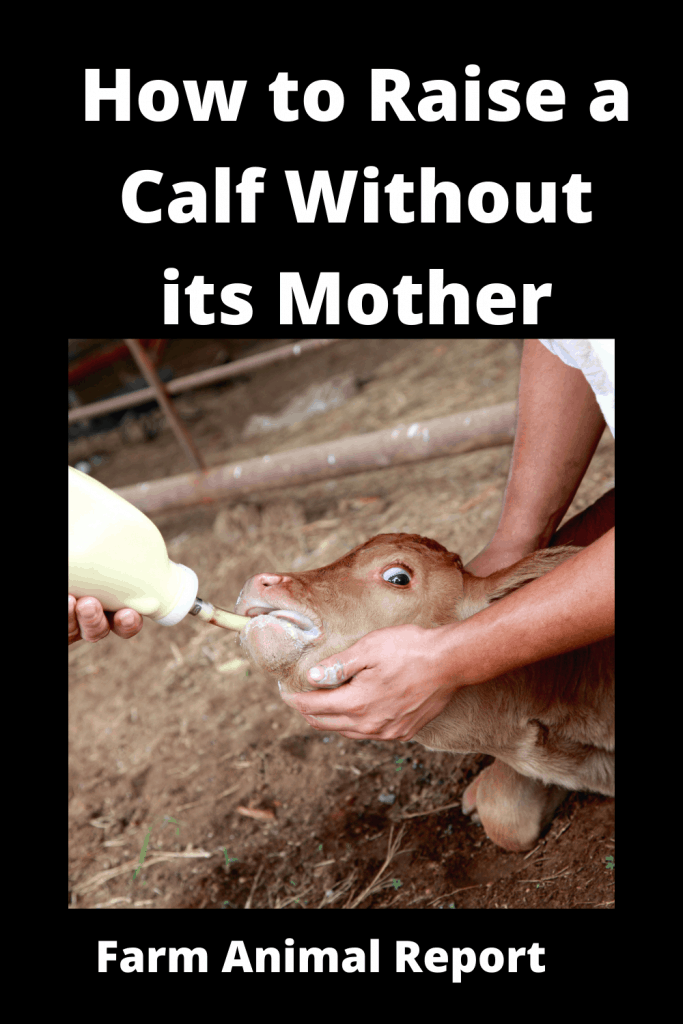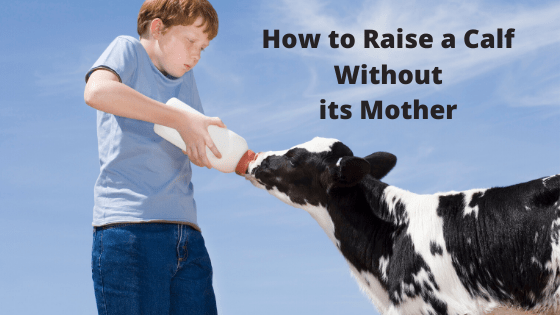How to Raise a Calf Without its Mother. Calves orphaned or abandoned present a unique set of challenges on a cow-calf operation. These situations arise not only from mothers dying at or shortly after birth, but also from behavioral or health issues that keep a cow or first-calf heifer from properly mothering her calf. Calves out of cows producing insufficient milk or born as multiples may need to be raised with special attention. In the dairy industry, calves are routinely separated from their mothers at very young ages. The resulting calves are sometimes referred to as “bucker” or “ bottle” calf.
To learn more about Raising Cattle Check out Amazons Resources
How to Raise a Calf Without its Mother / Initial Calf Care Priorities:
1. Colostrums Feeding:
The first priority in caring for a bottle calf is to ensure adequate colostrums intake. Fresh colostrums from the mother are the best and may require restraining and milking the mother or allowing the calf to nurse the restraining mother. This can be accomplished in a squeeze chute with removable sides that allow access to the udder.
In the case of orphaned calves, providing colostrums from another source is critical. The timing of colostrums intake is particularly important because the calf’s ability to absorb colostral antibodies decreases rapidly throughout the first day of life. Plan for calves to receive 5 to 6% of their body weight in colostrums within the first 6 hours after birth. Feed colostrums again 12 hours later.
2. Naval / Belly Button Care:
Naval care is another calving management practice that should receive priority. Apply iodine or a similar topical disinfectant to the umbilical cord of the newborn calf.
Continue to observe the naval closely to make sure that it dries and heals. Watch for signs of naval ill or infection, such as swelling of the naval. Muddy or wet calving grounds may to especially prone to providing naval infections. Treat infected naval immediately. Consult a veterinarian for treatment protocols.

3. Housing:
Provide calves with clean, well-ventilated pens and shelter from the weather. Calf hutches can be purchased or barn pens used to house bottle calves. Individual penning can help prevent calves from sucking one another and reduce the spread of disease.
It also facilitates individual monitoring of calf feed intake and feces consistency as signs of calf health. Allow 15 to 20 square feet barn space for calves with access to an outdoor lot and 20 to 30 square feet of barn space for those without outdoor lots.
See Our Guide – Ways to Make Money Cattle Farming
Milk Feeding Options:
For the first two weeks of life, calves receive most of their nutrition from milk. From four days of age, calves can be fed either whole milk, waste milk, reconstituted milk replacer, or fermented or fresh colostrums. The type of milk-fed is determined by price, availability, and convenience.
Calves are generally fed milk twice daily from a nipple, bottle or they can drink from an open bucket.
To prevent the spread of Johne’s disease to young calves, colostrum, fermented colostrum, whole milk, or waste milk should be obtained from cows testing negative for john’s disease.
Whole milk:
Whole milk can be used to feed baby calves. Calves should be fed daily approximately 10% of their birth baby weight. For example, a Holstein calf weighing 90 pounds at birth would be fed 4.5 quarts of milk daily or 2.25 quarts per feeding when fed twice daily.
Feeding less milk then this amount results in poor growth due to lack of needed nutrients. Overfeeding and sudden change in the amount of milk to calve decreases the consumption of dry feed or again, thus prolonging weaning time.
Waste Milk:
Waste or mastitic milk can be used to feed calves. Calves should be fed approximately 10% of their birth bodyweight. Milk from treated cows should only be used to feed calves raised for herd replacements or those kept for eight to 12 weeks after the last feeding of such milk.

Do not feed waste milk containing antibiotics to calves intended for slaughter. Calves should be individually housed so that they cannot suck one another. Do not feed calves waste milk that is watery or that comes from quarters showing signs of severe mastitis, from cows with an elevated temperature, from a cow that is off-feed, or from the cow shortly after they have been treated with antibiotics.
Milk Replacer:
Milk replacer powders are reconstituted with warm water and make an excellent and oftentimes economical liquid feed for baby calves. Especially during the first three weeks of life, calves should be fed a milk replacer that contains all milk proteins made from dried skim milk or whey products. Whey products can include whey protein concentrates, dried whey, and lactose whey.
Composition of Milk Replacer:
Milk replacer should contain the following :
- 18-22% crude protein
- 10-22% crude fat
- Less than 0.5% crude fiber
They should be mixed and fed according to the manufacturer’s directions. During cold weather, calves should be fed a milk replacer containing 20% fat, and more milk replacer powder should be fed.
In the absence of a nurse cow, use a milk replacer that contains at least 22% crude protein and 15% fat. Mix milk replacer with warm water to better dissolve the product and make it more attractive to the calf. Keep the temperature of the mix consistent between feeding and not more than 100 degrees Fahrenheit.
Also, use the same amount of milk replacer in the mix each feeding. Use separate bottles for each bottle calf to limit the risk of disease spread. Sanitize all feeding equipment after each meal. To protect human health, particularly that of susceptible young children, keep bottle feeding supplies out of human food preparation areas.
Fermented Colostrum:
Fermented or sour colostrum can be used to feed calves. Studies have shown that weight gains in calves are similar to those fed milk or milk replacers when fermented colostrum has been properly fermented and diluted when fed. Fermented colostrum represents all of the surplus milk and colostrum collected from cows for the first three days after calving.
This milk can be stored in a plastic garbage can be lined with a disposable plastic liner. Milk from the cow treated with antibiotics should not be added to fermenting colostrum since the antibiotics will kill the fermenting organisms. Colostrum ferments best when the temperature is between 60-80 degrees F and should be stored in direct sunlight.
Fermented colostrum takes approximately 10 to 14 days to ferment and can be stored an additional 14 to 30 days.
Calves can be fed fermented colostrum at four days of age. Fermented colostrum should be diluted with warm water at the rate of 1 part warm water to 2 parts fermented colostrum. Calves should be fed daily by approximately 10% of their birth weight of the reconstituted mixtures.
Raising the Grafting Calf: Surrogate Mother
Grafting a calf onto a beef cow in the herd that has lost a calf or another nurse cow purchased specifically for such use requires time and patience.
Pen nurse cows and calves separately from the rest of the herd in a space that allows the calf to interact closely with the cow. If the cow repeatedly kicks at or butts the calf and does not allow it to nurse, restrain her in a squeeze chute to allow nursing to take place twice a day. Repeat until the cow claims the calf willingly.
Give the cow opportunities to accept the calf without restraint. Rubbing or tying the skinned hide( skin over the back along with the tail) of the nurse cow’s dead calf onto the grafted calf can transfer scent and encourage the cow to accept the new calf.
Afterbirth and commercial products consisting of synthetic pheromones are other scents that can help in grafting. Using these scents may be helpful during the first two to three days but is not likely to help much after that period. The introduction of a light-bagged(full-uddered) cow and a hungry calf may be more likely to result in successful grafting.
How Can We Guide a Newly Born Calf about Feeding the Milk with the Bottle?
Although a calf may instinctively nurse its mother, it may need to be taught to drink from a bottle. Start by inserting one or two fingers into the calf’s mouth.
As the calf begins to suck, insert the bottle nipple in its mouth.
Straddling or standing beside the standing calf’s back and supporting its head upward while the calf is backed against a solid fence or wall( corner is best) may be needed when trying to feed a bottle. This head position will also help close the esophageal grooves present in young calves to shunt milk past the rumen and directly to the abomasum.
Lethargic or ill calves may require significant handling time before actively sucking a bottle. If a calf refuses to take a bottle, a stomach tube can be used to infuse milk replacer directly to the calf’s stomach. Take extreme care to ensure that the tube is in the esophagus and not the windpipe.
How Can We Handle the Ill Calves?
Listen to make sure that breathing sounds are not coming from the tube. Sometimes, the infusion of milk replacer into the stomach will stimulate a calf’s appetite. Weak calves may require more frequent feedings. Continue to monitor calves for signs of unthriftiness such as poor growth, scours, and a “pot-bellied” appearance.
Calf Starter and Water Important for Rumen Development:
For the first part of life, the calf functions as a simple-stomached or monogastric animal. At birth, the first three components of the stomach( the rumen, reticulum, and omasum) are undeveloped and do not aid in digesting the feeds for the very young calf. When the calf starts to eat a calf starter(a mixture of grains, protein sources, minerals, and vitamins) and to drink water, the rumen starts to develop.
Calf starter should be fed to calves starting at four days of age. Calf starter should be formulated to include very palatable ingredients and to contain adequate protein, minerals, and vitamins.
| Nutrient composition for calf starters |
| 16-20% crude protein 0.70% calcium0.45% phosphorus0.65%potassium10ppm copper40ppm zinc40ppm manganese0.10ppm cobalt1818 IU vitamin A/lb dry matter270 IU vitamin D/lb dry matter12 IU vitamin E/lb dry matter |
Weaning Calves:
Calves can be weaned from milk when they are eating daily 1.5 to 2 pounds of starter for three days in a row. Thus, calves should not be weaned based on age but rather on the basis of their intake of starter. Some calves can be weaned at four weeks of age, whereas others may be up to 10 weeks of age. Calves can be weaned from milk either abruptly or gradually over three to seven days.
Feeding Calves Shortly After Weaning:
After weaning, changes in the grain mix and group housing should be made one at a time, and changes should be made gradually over a two-week period. Heifers from two or four months of age should be grouped in small groups of four to six heifers. Calves need to stay in a small group for the first two months after weaning so that they can adjust to group feeding and to minimize competition among heifers for feeding.
Excellent quality hay should be fed to Holstein’s calves after they are consuming 5 to 6 pounds of grain daily. Once the heifers are consuming their grain, the best quality hay needs to be allocated to these young heifers.
Heifer should not be fed grain mixes containing urea or silages or pasture as the sole forage until after they are four months of age. Grain mixes fed from two to three months of age should contain 18% crude protein assuming early cut alfalfa/grass hay is fed containing 18% crude protein and 35% acid detergent fiber.
Management Practices:
At birth, calves should be identified with an ear tag or tattoo and/or a sketch or photograph. Records should be kept to identify the birth date and at least the sire and dam of each heifer.
At birth, calves can be given an oral vaccine to prevent scours. However, preference is to vaccinate the dry cow to provide the calf with the needed protection through the consumption of the dam’s colostrum.
Resources – Cattle Associations
- National Cattlemen’s Beef Association
- Ohio Cattlemen’s Association
- United States Cattlemen’s Association
- American Angus Association
- Holstein USA


